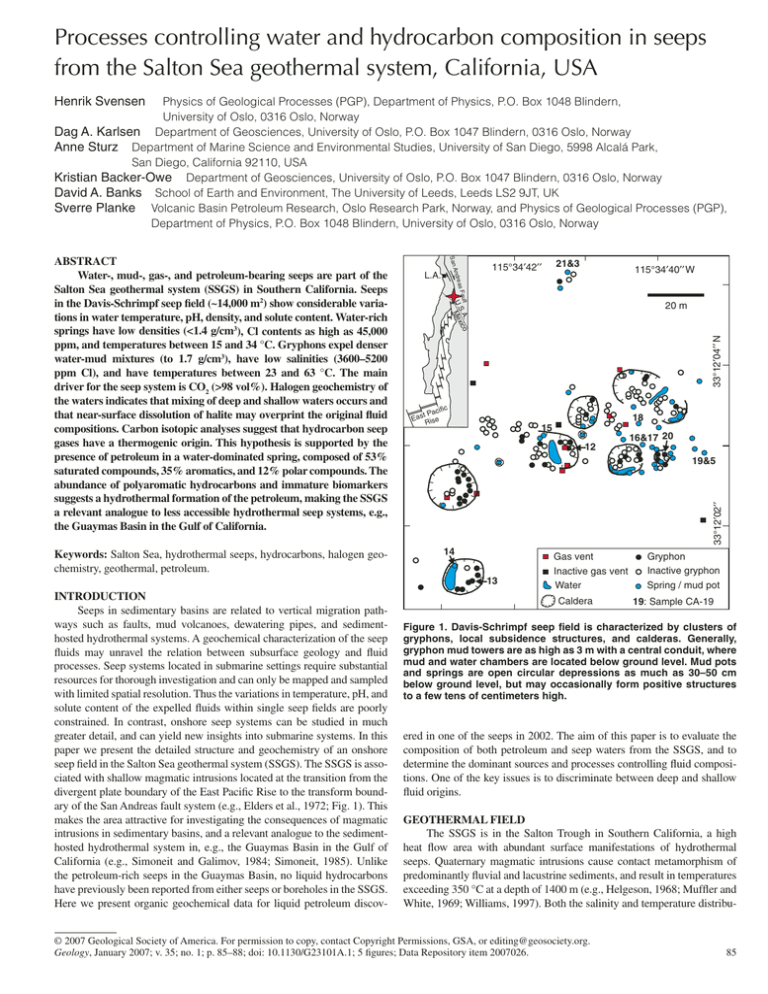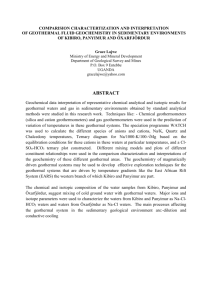Processes controlling water and hydrocarbon composition in seeps
advertisement

Processes controlling water and hydrocarbon composition in seeps from the Salton Sea geothermal system, California, USA Henrik Svensen Physics of Geological Processes (PGP), Department of Physics, P.O. Box 1048 Blindern, University of Oslo, 0316 Oslo, Norway Dag A. Karlsen Department of Geosciences, University of Oslo, P.O. Box 1047 Blindern, 0316 Oslo, Norway Anne Sturz Department of Marine Science and Environmental Studies, University of San Diego, 5998 Alcalá Park, San Diego, California 92110, USA Kristian Backer-Owe Department of Geosciences, University of Oslo, P.O. Box 1047 Blindern, 0316 Oslo, Norway David A. Banks School of Earth and Environment, The University of Leeds, Leeds LS2 9JT, UK Sverre Planke Volcanic Basin Petroleum Research, Oslo Research Park, Norway, and Physics of Geological Processes (PGP), Department of Physics, P.O. Box 1048 Blindern, University of Oslo, 0316 Oslo, Norway Keywords: Salton Sea, hydrothermal seeps, hydrocarbons, halogen geochemistry, geothermal, petroleum. ault S.A. ico as F U. Mex Andre San 115°34′42′′ 115°34′40′′ W 20 m cif t Pa Eas ise R ic 15 18 ′ 12 16&17 20 19&5 14 13 INTRODUCTION Seeps in sedimentary basins are related to vertical migration pathways such as faults, mud volcanoes, dewatering pipes, and sedimenthosted hydrothermal systems. A geochemical characterization of the seep fluids may unravel the relation between subsurface geology and fluid processes. Seep systems located in submarine settings require substantial resources for thorough investigation and can only be mapped and sampled with limited spatial resolution. Thus the variations in temperature, pH, and solute content of the expelled fluids within single seep fields are poorly constrained. In contrast, onshore seep systems can be studied in much greater detail, and can yield new insights into submarine systems. In this paper we present the detailed structure and geochemistry of an onshore seep field in the Salton Sea geothermal system (SSGS). The SSGS is associated with shallow magmatic intrusions located at the transition from the divergent plate boundary of the East Pacific Rise to the transform boundary of the San Andreas fault system (e.g., Elders et al., 1972; Fig. 1). This makes the area attractive for investigating the consequences of magmatic intrusions in sedimentary basins, and a relevant analogue to the sedimenthosted hydrothermal system in, e.g., the Guaymas Basin in the Gulf of California (e.g., Simoneit and Galimov, 1984; Simoneit, 1985). Unlike the petroleum-rich seeps in the Guaymas Basin, no liquid hydrocarbons have previously been reported from either seeps or boreholes in the SSGS. Here we present organic geochemical data for liquid petroleum discov- 21&3 33°12′04′′ N L.A. 33°12′02′′ ABSTRACT Water-, mud-, gas-, and petroleum-bearing seeps are part of the Salton Sea geothermal system (SSGS) in Southern California. Seeps in the Davis-Schrimpf seep field (~14,000 m2) show considerable variations in water temperature, pH, density, and solute content. Water-rich springs have low densities (<1.4 g/cm3), Cl contents as high as 45,000 ppm, and temperatures between 15 and 34 °C. Gryphons expel denser water-mud mixtures (to 1.7 g/cm3), have low salinities (3600–5200 ppm Cl), and have temperatures between 23 and 63 °C. The main driver for the seep system is CO2 (>98 vol%). Halogen geochemistry of the waters indicates that mixing of deep and shallow waters occurs and that near-surface dissolution of halite may overprint the original fluid compositions. Carbon isotopic analyses suggest that hydrocarbon seep gases have a thermogenic origin. This hypothesis is supported by the presence of petroleum in a water-dominated spring, composed of 53% saturated compounds, 35% aromatics, and 12% polar compounds. The abundance of polyaromatic hydrocarbons and immature biomarkers suggests a hydrothermal formation of the petroleum, making the SSGS a relevant analogue to less accessible hydrothermal seep systems, e.g., the Guaymas Basin in the Gulf of California. Gas vent Inactive gas vent Water Caldera Gryphon Inactive gryphon Spring / mud pot 19: Sample CA-19 Figure 1. Davis-Schrimpf seep field is characterized by clusters of gryphons, local subsidence structures, and calderas. Generally, gryphon mud towers are as high as 3 m with a central conduit, where mud and water chambers are located below ground level. Mud pots and springs are open circular depressions as much as 30–50 cm below ground level, but may occasionally form positive structures to a few tens of centimeters high. ered in one of the seeps in 2002. The aim of this paper is to evaluate the composition of both petroleum and seep waters from the SSGS, and to determine the dominant sources and processes controlling fluid compositions. One of the key issues is to discriminate between deep and shallow fluid origins. GEOTHERMAL FIELD The SSGS is in the Salton Trough in Southern California, a high heat flow area with abundant surface manifestations of hydrothermal seeps. Quaternary magmatic intrusions cause contact metamorphism of predominantly fluvial and lacustrine sediments, and result in temperatures exceeding 350 °C at a depth of 1400 m (e.g., Helgeson, 1968; Muffler and White, 1969; Williams, 1997). Both the salinity and temperature distribu- © 2007 Geological Society of America. For permission to copy, contact Copyright Permissions, GSA, or editing@geosociety.org. GEOLOGY, January 2007 Geology, January 2007; v. 35; no. 1; p. 85–88; doi: 10.1130/G23101A.1; 5 figures; Data Repository item 2007026. 85 1.8 1.7 3 Fluid density (g/cm ) tion of hydrothermal fluids from boreholes suggest that there is a fluid density interface between deep saline brines and less saline shallow waters (Williams and McKibben, 1989; Williams, 1997). The Davis-Schrimpf field (Fig. 1) is a seep locality with vigorous activity throughout the year (Muffler and White, 1968; Sturz et al., 1992). Carbon dioxide produced from devolatilization reactions in the hydrothermal system is the main driver for the seep activity, and the seep field is located close to a shallow (150–200 m depth) sandstone CO2 reservoir. The CO2 locally flows to the surface together with brine and mud, forming mud pots, gryphons, and springs. The water seeps from the Davis-Schrimpf field are Na-Cl brines, possibly of shallow meteoric origin with a component of hypersaline hydrothermal reservoir fluids (Sturz et al., 1992). 1.6 1.5 Gryphons 1.4 Springs 1.3 1.2 1.1 SEEP FIELD STRUCTURE AND GEOCHEMISTRY At the Davis-Schrimpf seep field, which covers an area of ~120 × 120 m, gas, mud, and water are expelled from springs, gryphons, mud pots, and gas vents (Fig. 1; see GSA Data Repository Figs. DR1 and DR21). The seeps can be divided into two groups based on the density of the expelled water-mud mixture measured at 31 individual seeps. Seeps with low densities (<1.4 g/cm3) are water rich and form pools, whereas mud-rich waters (>1.4 g/cm3; Fig. 2) characterize the gryphons. Waterdominated seeps have temperatures between 15 and 32 °C, whereas muddominated seeps are hotter, between 22 and 62 °C (Fig. 2). A spring in the eastern part of the field (Fig. 1; CA-19) had a distinct smell of petroleum. WATER GEOCHEMISTRY The waters seeping from the Davis-Schrimpf seep field are Na-Cl waters with Cl concentrations between 3668 and 44,692 ppm (Fig. 3; Table DR1 [see footnote 1]). Our data show that the waters from gryphons have lower salinities (3600–5200 ppm Cl) than the colder waters from springs 1 GSA Data Repository item 2007026, Figures DR1–DR4, Table DR1, and Table DR2, field photographs and oil, gas, and water geochemistry, is available online at www.geosociety.org/pubs/ft2007.htm, or on request from editing@geosociety.org or Documents Secretary, GSA, P.O. Box 9140, Boulder, CO 80301, USA. 86 1.0 10 30 50 Temperature ( C) 70 1.8 1.7 Fluid density (g/cm3) METHODS Detailed mapping of gryphons, gas vents, mud pots, and springs at the Davis-Schrimpf seep field was done in 2002 using a Garmin Etrex global positioning system and corrected by field observations (Fig. 1). Temperature measurements were performed in December 2003 using a thermocalc thermometer with a reported accuracy of ±0.5 °C, and in situ pH was measured with an Orion 250A. The densities of expelled mud and waters were measured by a commercial electronic scale. Cations for 10 water samples were measured by inductively coupled plasma mass spectroscopy (Agilent 7500c), and anions were measured by ion chromatography using a Dionex DX-500 at the School of Earth and Environment, Leeds, UK. Precision in all instances was better than 5% RSD (residual standard deviation) and accuracy better than 4%. Gas chromatography and carbon isotopic composition of sampled gases (CO2, CH4, and C2H6) were done at the Institute for Energy Technology at Kjeller, Norway, using a Finnigan MAT DeltaXP isotope ratio mass spectrometer. The results are reported as permil versus the Vienna Peedee belemnite standard. Selected mud-water mixtures were dried at 30 °C for 2 days and the sediment was treated with a standard dichloromethane-methanol mixture (93:7 vol%) to extract bitumen, and analyzed on an Iatroscan thin layer chromatography–flame ionization detector (FID) at the University of Oslo. Separation of the extract into saturated hydrocarbons, aromatic hydrocarbons, and a polar fraction constituting asphaltenes and resins followed the procedure outlined by Karlsen and Larter (1991). The core extract was analyzed by capillary gas chromatography with FID (GC-FID) and by mass spectrometry (GC-MS). 1.6 1.5 1.4 1.3 1.2 1.1 1.0 5.0 5.4 5.8 pH 6.2 6.6 Figure 2. Relationship between density, pH, and temperature for fluid and mud mixtures from 31 individual seeps. Upper figure shows that high-density-mud–dominated seeps (from gryphons) are characterized by wider range of temperatures compared to water-dominated seeps. High-density mixtures are hotter than water-dominated seeps. Temperature differences are not coupled with any systematic changes in pH (lower figure). (9500–45,000 ppm Cl). In situ pH measurements gave results between 5.2 and 6.3, with no trend versus temperature or density or between gryphons and springs (Fig. 2). The highest measured water Cl− concentration is from the petroleum-bearing spring (CA-19; 44,692 ppm). The Cl/Br ratio varies from 1027 to 5099 (by mass), and 4 of the waters from springs have a Cl/Br ratio >3000. This is significantly higher than Salton Sea surface water (Cl/Br 1308), drainage water from the area (Cl/Br 1300), and the geothermal reservoir brines (Cl/Br 1300–1500). The halogen data from our 10 samples and more than 90 unpublished water analyses from the seep field show that the water compositions define two distinct trends (Fig. 3). Trend 1 waters have Cl/Br ratios close to 1300, whereas the salinity reaches that of the highsalinity geothermal brines. In contrast, trend 2 waters reach extremely high Cl/Br ratios and have Br concentrations <10 ppm (~0.13 mM). GAS GEOCHEMISTRY Two gas samples (CA-3 and CA-5) were collected, one from a pure gas vent in the northern part of the field (Fig. 1), and one from the petroleum-bearing spring. Both samples have a similar gas composition, with 99.5% CO2, 0.5% CH4, and <0.1% C2H6 (Table DR2; see foot- GEOLOGY, January 2007 9000 0.010 Salton Sea 6000 Irrigation water 5000 Drainwater High Drainwater Median 4000 Seawater 3000 0.008 0.005 0.003 Trend 1 2000 i-C19 i-C20 Cl/Br (mass) A. Sturz, unpubl. data Trend 2 C14 Low TDS 7000 Relative response Hypersaline UCM i-C22 8000 Pr Ph This study BMH 1000 20 0 0 50000 100000 150000 200000 Cl ppm Figure 3. Analyses of gryphon and spring water (n = 10) collected from Davis-Schrimpf field in 2002 show wide range in Cl and Br contents. Additional 98 analyses of seep waters collected from 1993 to 2003 are included (Sturz et al., 1992). Compositions of waters define − two trends in Cl Br space. Compositions of Salton Sea water, irrigation water, drain water (Schroeder, 1996), and deep saline Salton Sea geothermal system waters (Williams and McKibben, 1989) are shown for reference. TDS—total dissolved solids. note 1). The gas samples have similar δ13C carbon isotopic ratios for CO2 (−5.3‰/–5.4‰), and CH4 (−32.7‰/–32.0‰). The ratio for C2H6 in the petroleum-bearing sample is −20.1‰. ORGANIC GEOCHEMISTRY OF PETROLEUM The composition of the extracted bitumen from sample CA-19 is 60% saturated hydrocarbons, 25% aromatic hydrocarbons, and 15% polar compounds (i.e., resins and asphaltenes). This composition is within the range for conventional petroleum (cf. Tissot and Welte, 1984). The petroleum has a bimodal baseline distribution with an unresolved complex mixture, resulting from biodegradation (Fig. 4). Furthermore, it contains a biomarker hump typically observed in immature to low-maturity source-rock extracts. The petroleum is characterized by nonizomerized homohopanes, suggesting a low maturity, consistent with the biomarker hump and an aromatic hydrocarbon signature (Figs. DR3 and DR4; see footnote 1). The biomarkers contain abundant tertiary and quaternary carbons with a lower thermal stability than secondary carbons (n-alkanes), and therefore easily alter to smaller and more stable molecules. The n-alkanes are present in small concentrations relative to some of the isoprenoids like pristane (Pr) and phytane (Ph) and other isoalkanes and cycloalkanes. Only traces of monoaromatic hydrocarbons are present in the sample, while the lesswater-soluble polyaromatic hydrocarbons are abundant. This result is supported by GC-MS analysis of the bitumen, which shows increasing proportions going from naphthalenes to phenanthrenes, whereas the opposite is found in conventional oils (Tissot and Welte, 1984) (Fig. DR4). DISCUSSION Controls on Seep Water Composition There is a correlation between the seep temperature and the bulk density of the expelled water-mud mixtures. Water-rich seeps are generally colder, which can be explained by more efficient heat loss during mixing with a large fluid reservoir. It has been proposed that the salinity variations and the high Cl/Br ratios in the waters reflect heterogeneous mixing between deep saline and shallow meteoric waters (e.g., Sturz et al., 1992). The trend 1 salinity variations of the seep waters can accordingly be explained by mixing between a meteoric end member and saline brines GEOLOGY, January 2007 30 40 Time (min) 50 60 Figure 4. Organic geochemistry of CA-19 seep fluid. Gas chromatography with flame ionization detector chromatogram of mud extract shows occurrence of homologous series of normal alkanes (n-Cxx) and isoalkanes (i-Cxx). Presence of unresolved complex mixture (UCM) and high concentrations of Pr and Ph suggests influence from biodegradation. Biomarker hump (BMH) is typical for source rocks with low to moderate maturity. with a deep geothermal reservoir origin. However, none of the waters sampled for this study plot on the high salinity side of trend 1. This may reflect a strong temporal variation in water composition and a nonuniform leakage from the high salinity geothermal reservoir. The high sulfate and magnesium concentrations furthermore support a meteoric component in our samples, as both the drain water in the Salton Trough and the Salton Sea are enriched in Mg and SO4 (Table DR1; see footnote 1). An important observation for understanding fluid composition is the apparent low net flow of water from the seep area, leading to stagnant water in the springs and pools. Halite starts precipitating at Cl concentrations of ~145,000 ppm (Fontes and Matray, 1993), which is higher than the concentrations measured in the waters (Fig. 3). During in situ evaporation within stagnant pools, their salinity will increase; however, Cl/Br ratios will remain low until halite saturation is reached. The high Cl/Br ratios of the seep fluids (to 5099) are close to the Cl/Br ratio for pure halite (Cl/Br 3000–9000; McCaffrey et al., 1987), implying that the end-member trend 2 composition may represent waters that have dissolved surface halite crusts. The extremely high Cl/Br waters at the end of trend 2 were all sampled during summer, supporting a seasonal variation in water composition. Gas Source The δ13C value for CO2 (−5.3‰) shows that the main source of gas is decarbonation reactions, likely involving calcite and dolomite at temperatures between 150 and 200 °C (Muffler and White, 1968; Williams and McKibben, 1989). Furthermore, the overpressure generated during CO2 production drives the fluid flow and the seeps. The methane dominance over higher hydrocarbons, and the δ13C1 value of −32‰, suggests a thermogenic, possibly terrigenous, source at relatively elevated temperatures (cf. Whiticar, 1994). This interpretation is supported by the isotopically heavy ethane (−20.1‰). Methane and ethane appear to be cogenetic and generated from rapid maturation of organic matter. Thus the carbon gas system in the SSGS resembles the one in the Guaymas Basin, where the CO2 is partly derived from mineral reactions and the CH4 is enriched in 13C in contact aureoles adjacent to shallow sill intrusions (Simoneit and Galimov, 1984). Petroleum Formation The petroleum composition of the extracts from the spring reflects, in gross terms, immature bitumen due to the comparatively low content 87 of polar compounds (cf. Tissot and Welte, 1984). The bitumen in the seep may originate from several cycles of petroleum generation, each of which has been partly biodegraded. The biodegradation is incomplete, because isoprenoids and isoalkanes are still present. Preferential loss of the more water-soluble aromatic hydrocarbons suggests that these are effectively partitioned into the water phase en route to the surface (cf. Kawka and Simoneit, 1990). The hydrocarbon composition deviates distinctly from kerogen pyrolysis products, which tend to be dominated by polar compounds and often contain <10%–20% saturated hydrocarbons (cf. Karlsen and Larter, 1991). However, several distinct compositional features suggest that the petroleum is hydrothermally derived rather than formed from normal maturation during slow basin subsidence (cf. Simoneit, 1990): (1) polyaromatic hydrocarbons are more abundant than monoaromatic hydrocarbons; (2) immature hopanoids and sterane biomarkers are present; (3) three-ring aromatic steroids are present; and (4) heterocompounds are present, as common in all low to medium mature petroleum systems. The presence of unsaturated alkanes (i.e., alkenes) should be expected in hydrothermally generated petroleum, but the absence in the seeps is probably due to hydrogenation reactions induced by the hot water. This is also the case for the Guaymas Basin seep petroleum (Leif and Simoneit, 2000), where the petroleum compositions range from being hydrothermally generated to hydrothermally altered (Simoneit et al., 1996). CONCLUSIONS Tracing fluid sources and distinguishing between deep and shallow processes are major challenges in seep studies. The SSGS is in this respect a very promising field area, with relevance for understanding less accessible areas in submarine settings, such as the Guaymas Basin. We conclude that the SSGS is responsible for an accelerated production and maturation of both gas and liquid range hydrocarbons. Carbonate metamorphism and CO2 production at depth is the main driver for the seep activity. The large range in fluid composition reflects, in part, the competition between deep and shallow processes in controlling fluid composition, and can explain the two observed mixing trends (Fig. 5). The water geochemistry suggests a strong temporal variation in composition and that there may be a considerable seasonal effect on water salinity and Cl/Br ratios. This emphasizes the complexities in using seep sites for monitoring deep fluid reservoirs. Seeps Meteoric Sandstone reservoir CO2 Depth (km) 0.5 150 C 1.0 1.5 ite Dolom Calcite HC Trend 1 200 C e fac ne Bri 250 C r inte Convection 300 C 3 2 1 0 Length (km) Figure 5. Schematic cross section of Salton Sea geothermal system, showing location of Davis-Schrimpf seep field in red. Seeps are driven by CO2 released from decarbonation reactions within 150–200 °C interval. Temperature contours and position of interface between deep highly saline brines and shallow brines are based on Williams (1997). Trend 1 waters have component of deep saline brines mixed with low- to moderate-salinity surface waters. Trend 2 waters have shallow origin. 88 ACKNOWLEDGMENTS We gratefully acknowledge support from the Norwegian Research Council (grant NFR-163469), the University of San Diego (USD) Faculty Research Grant to the Mud Pots Project, and the undergraduate students at USD who collected samples and performed chemical analyses for some of the data reported here. We thank Bernd R.T. Simoneit and Randolph A. Koski for constructive reviews. REFERENCES CITED Elders, W.A., Rex, R.W., Meidav, T., Robinson, P.T., and Biehler, S., 1972, Crustal spreading in southern California: Science, v. 178, p. 15–24. Fontes, J.C., and Matray, J.M., 1993, Geochemistry and origin of formation brines from the Paris Basin, France. 1. Brines associated with Triassic salts: Chemical Geology, v. 109, p. 149–175, doi: 10.1016/0009–2541(93)90068-T. Helgeson, H.C., 1968, Geologic and thermodynamic characteristics of the Salton Sea geothermal system: American Journal of Science, v. 266, p. 129–166. Karlsen, D.K., and Larter, S.R., 1991, Analysis of petroleum fractions by TLCFID, applications to petroleum reservoir description: Organic Geochemistry, v. 17, p. 603–617, doi: 10.1016/0146–6380(91)90004–4. Kawka, O.E., and Simoneit, B.R.T., 1990, Polycyclic aromatic hydrocarbons in hydrothermal petroleums from the Guaymas Basin spreading center: Applied Geochemistry, v. 5, p. 17–27. Leif, R.N., and Simoneit, B.R.T., 2000, The role of alkenes produced during hydrous pyrolysis of a shale: Organic Geochemistry, v. 31, p. 1189–1208, doi: 10.1016/S0146–6380(00)00113–3. McCaffrey, M.A., Lazar, B., and Holland, H.D., 1987, The evaporation path of seawater and the coprecipitation of Br- and K+ with halite: Journal of Sedimentary Petrology, v. 57, p. 928–937. Muffler, J.L.P., and White, D.E., 1968, Origin of CO2 in the Salton Sea geothermal system, southeastern California, U.S.A: XXIII International Geological Congress Proceedings, v. 17, p. 185–194. Muffler, J.L.P., and White, D.E., 1969, Active metamorphism of the upper Cenozoic sediments in the Salton Sea geothermal field and the Salton trough, southern California: Geological Society of America Bulletin, v. 80, p. 157–182. Schroeder, R.S., 1996, Transferability of environmental assessments in the Salton Sea Basin, California, and other irrigated areas in the western United States to the Aral Sea Basin, Uzbekistan, in Micklin, P.P., and Williams, W.D., eds., The Aral Sea Basin: Dordrecht, Netherlands, Kluwer Academic Publishers, p. 121–137. Simoneit, B.R.T., 1985, Hydrothermal petroleum: Genesis, migration and deposition in Guaymas Basin, Gulf of California: Canadian Journal of Earth Sciences, v. 22, p. 1919–1929. Simoneit, B.R.T., 1990, Petroleum generation, an easy and widespread process in hydrothermal systems: An overview: Applied Geochemistry, v. 5, p. 3–15, doi: 10.1016/0883–2927(90)90031-Y. Simoneit, B.R.T., and Galimov, E.M., 1984, Geochemistry of interstitial gases in Quaternary sediments of the Gulf of California: Chemical Geology, v. 43, p. 151–166, doi: 10.1016/0009–2541(84)90145–1. Simoneit, B.R.T., Leif, R.N., and Ishiwatar, R., 1996, Phenols in hydrothermal petroleums and sediment bitumen from Guaymas Basin, Gulf of California: Organic Geochemistry, v. 24, p. 377–388, doi: 10.1016/0146– 6380(96)00008–3. Sturz, A.A., Kamps, R.L., and Earley, P.J., 1992, Temporal changes in mud volcanoes, Salton Sea geothermal area, in Kharaka, Y.K., and Maest, A.S., eds., Water-rock interaction: Rotterdam, Balkema, p. 1363–1366. Tissot, B.P., and Welte, D.H., 1984, Petroleum formation and occurrence (second edition): Berlin, Springer Verlag, 699 p. Whiticar, M.J., 1994, Correlation of natural gases with their sources, in Magoon, L.B., and Dow, W.G., eds., The petroleum system—From source to trap: American Association of Petroleum Geologists Memoir 60, p. 261–283. Williams, A.E., 1997, Fluid density distribution in a high temperature, stratified thermohaline system: Implications for saline hydrothermal circulation: Earth and Planetary Science Letters, v. 146, p. 121–136, doi: 10.1016/ S0012–821X(96)00206–3. Williams, A.E., and McKibben, M.A., 1989, A brine interface in the Salton Sea geothermal system, California: Fluid geochemical and isotopic characteristics: Geochimica et Cosmochimica Acta, v. 53, p. 1905–1920, doi: 10.1016/0016–7037(89)90312–8. Manuscript received 14 July 2006 Revised manuscript received 4 September 2006 Manuscript accepted 7 September 2006 Printed in USA GEOLOGY, January 2007 Data Repository Item DR2007026 Gryphons and caldera DR1 Henrik Svensen Page 1 B Petroleum-bearing spring DR2 Active gryphons Water sample CA-19 Gas sample CA-5 29ab 29ba 30ab 30ba 31abS 31abR 32abS 10 DMN 25 80 84 92 88 minutes 27Tm 29ab 30ab 25/3R+S 24/4 5 50 DR4 100 Relative percent 27Tm 15 24/3 21/3 75 DR3 20 20/3 Relative response 100 m/z=191 23/3 “Caldera pond” TMN 50 MN 0 50 60 70 80 Time (minutes) 90 11 100 GC-MS chromatogram. The complete series of tricyclic, tertracyclic, and pentacyclic terpanes are identified in the extracts, albeit several of the hopanes are missing or underrepresented due to low maturity (see expanded insert). Davis-Schrimpf field CA-12 gryphon CA-13 gryphon CA-14 spring CA-15 spring CA-16 spring CA-17 spring CA-18 spring CA-19 spring with oil CA-20 mud pool CA-21 spring 5234 3668 20638 9503 18119 18865 13585 44692 16119 10171 4.4 2.1 6.3 3.9 5.8 3.7 7 12.5 6.1 9.9 5191 5317 465 257 348 395 403 4835 1406 <20 5037 3600 10112 5367 10142 10300 8342 28400 10735 6425 392 266 359 180 460 182 390 990 735 272 772 785 682 154 252 402 400 1572 815 238 162 120 257 57 135 145 110 717 202 106 13 11 17 9 18 19 16 49 27 18 Other seep fields Sportsman* Section 26 mudpots* 8920 23200 9.1 25 414 5430 1520 10800 334 292 435 1790 69 1670 12 Deep brines (from boreholes) Hypersaline brine** 151000 Low salinity brine** 31000 99 24 33 54 194 55 Salton Sea area waters*** Salton Sea 17000 Irrigation water 92 Drainwater 1200 * Muffler and White (1968) ** Williams and McKibben (1989) *** Schroeder (1996) 53000 16700 27400 15000 2480 2520 13 10000 11000 0.068 270 110 1 3000 2000 220 4.3 19 950 76 310 1300 29 330 13 CA03-3 CA03-5 CO2 % 99.5 99.5 CH4 % 0.5 0.5 ppm seep gas 167109 596140 16 17 1 3 2 2 2 2 1 1 2 10 Sr Fe Mn Pb Zn Cl/Br 24 14 32 9 18 19 19 54 33 20 5 6 5 5 6 5 5 4 16 4 4 6 0.2 <.2 <.2 <.2 1 3 6 3 <.2 1 0.4 0.3 0.3 0.2 0.2 0.3 <.2 28 21 10 24 17 30 30 31 35 20 27 1190 1747 3276 2437 3124 5099 1941 3575 2642 1027 10 1 980 928 3.4 Table DR2. Table 4. Composition of seep gas ( C as permil vs. VPDB) B Sample 13 14 15 Time (minutes) The GC-MS chromatogram shows that the full range of methylnaphthalenes (MN), dimethylnaphthalenes (DMN), and trimethylnaphthalenes (TMN) are present in the CA-19 petroleum, indicating no isomer-specific biodegradation, whilst the opposite is typical for natural oils. Table A. Composition of waters from the Salton Sea Geothermal System. All values in ppm. Table DR1. Sample Structure Cl Br SO4 Na K Ca Mg Li Ba 65 53 12 CO2 CH4 C2 H6 13C 13C 13C -5.3 -5.4 -32.7 -32.0 -20.1 203 45 411 112 1560 86 1450 60 3.4 1.1 12 0.34 0.08 0.005 0.002 0.11 0.08 100 2.6 518 11 1525 1292 1308 1353 1200





